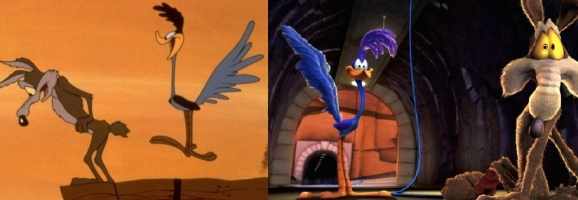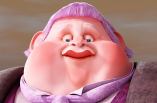Animation in the Video Game Generation: Tradition vs. Technology

Is 2D animation dead?
Former Disney animator Raul Aguirre Jr. appears to think so, given his plans for a mock memorial service for hand drawn animation at this year’s San Diego Comic-Con. It’s a question that continues to be a bone of contention among animation enthusiasts, journalists and industry professionals across a plethora of articles and message boards; since industry giant Disney apparently turned its back on the 2D feature film after 2009’s The Princess and the Frog, the hand drawn style has all but disappeared from mainstream cinema. With competitors Dreamworks and Fox having left traditional animation behind in favour of the three dimensional CG style afforded by technological advances almost a decade earlier, the definitive producers of feature length cartoons have finally ceded and joined their sister company Pixar in the realms of CG animation.
So why the apparent decline in hand drawn animation? Cost is certainly a factor; it used to be the case that 2D animation was considerably cheaper to produce than its 3D counterpart due to the differences in the production process. Whilst 3D animation was dependent on expensive computer packages, 2D animation could be produced comparitively cheaply with the traditional cel based method. Before the advent of digital animation, characters were hand painted onto transparent sheets of celluloid (cels) which were overlain atop an opaque background. The cels were held in place with the registration holes, holes along the top or bottom of the sheet that correspond to the peg bar on the lightbox, and flattened with a sheet of glass to ensure alignment whilst the frame was photographed.
In 1990, Disney implemented a new system called CAPS (Computer Animation Production System), developed in co-operation with Pixar. This new system replaced the costly process of painting on cels, enabling animators to scan line drawings into a computer and colour them digitally before compositing them over a similarly scanned background. In recent years, further technological developments have made it possible to create animated films single handedly with nothing but a computer, a graphics tablet, and a couple of pieces of affordable software; the ink-and-paint process has become fully digitised whilst maintaining a semblance of the traditional method.
The digitisation of 2D animation came only a few short years before Pixar’s first feature film, the massively successful Toy Story of 1995. Beginning with George Lucas’ recruitment of Ed Catmull to Lucasfilm’s Computer Division in 1979, the technology and visual style that Pixar has become known for was swift to develop. Steve Jobs bought the Computer Division from Lucas in 1986 to create the independent company known as Pixar; shortly after, John Lasseter’s Luxo Jr. was completed and nominated for an Oscar. The next few years saw the creation of a number of successful shorts, award nominations, and advances in the animation technology.
There can be no doubt that these technological advances have, if nothing else, allowed for a greater complexity in animation; digitisation of the 2D style has led to possibilities with lighting and camera movement that were previously much more difficult if not impossible. Likewise, 3D packages such as Maya allow for incredibly complex character and set designs, lighting, rendering and camera movements. Models can be intuitively animated with rigs, a sort of manipulatable skeleton, and programmed with movement cycles.
With the difference in production costs having become considerably less dramatic, an animator’s choice in style would appear to have more to do with his intended audience than his budget. Whilst CG has been the prevalent style at the box office in recent years, this is most likely due to the success and popularity of the films of Pixar and their competitors, as well as the popularity of games and gadgets with the present generation. Whereas once the landscape of animation was dominated by the likes of Hanna-Barbera, Warner Bros., and Disney, all of whom produced hand drawn 2D programmes, today’s children are surrounded by games consoles, video games, and franchises.
Video games and TV shows with a related line of toys are not a new idea; the Pokemon franchise, for example, covers a number of video games, toy lines, themed clothing, and a plethora of other collectibles. Whilst Pokemon still appears to be going strong, another current example might be Activision’s Skylanders, a video game which features the gimmick of importing a series of figurines into the game with a ‘Portal of Power’ , a platform which reads the character model and places it in the game. The concept is not unlike that of Tecmo’s 1997 Monster Rancher which allowed players to scan new monsters from any readable CD they happened to have to hand. What Activision have done, however, is maximise their profits by selling the figurines and the game separately.
And profits, indeed, are what would appear to be the deciding factor in the choosing of an animation style. CG does does well at the box office in no small part because its computer generated visuals bear a resemblance to those of the video games its target audience enjoy. This is turn leads to the production, and presumably reasonable success of, spin-off video games and toys; Brave, for instance, saw a number of small games developed for its release, including a themed version of the popular Temple Run game. Likewise, themed versions of Angry Birds include Rio and Star Wars.
Of course, a unity of style is not a new idea either. Such children’s programmes as Thomas the Tank Engine and Noddy’s Toyland Adventures were animated in stop-motion, giving the impression that the toys themselves had come to life. Both series have been updated in recent years and are now animated in CG, no doubt for the reasons outlined above. Other classic characters have received similar treatment, such as Bugs and Daffy, and Wile E. Coyote and the Roadrunner in The Looney Tunes Show, a sitcom style reboot of Looney Tunes.
2D cartoons are by no means gone, however; Cartoon Network still show such favourites as Johnny Bravo, Courage the Cowardly Dog, and Dexter’s Laboratory after 9PM, suggesting that these shows are targeted at an audience who watched them as children. Similarly, such shows as Adventure Time and Regular Show would appear to be targeted largely at an audience in their twenties and beyond. Regular Show, certainly, is rife with references to the 80’s, classic video games and pop culture. Shows such as The Simpsons, South Park, and Family Guy also remain stalwart favourites with a teenage and adult audience, and of course anime works such as those of Studio Ghibli remain popular with Western audiences.
It would be remiss, then, to claim in honesty that 2D animation is dead. The traditional methods of hand drawn animation, indeed, may be said to be so given the implementation of digital painting and compositing, but the style itself maintains as strong a presence as ever, having simply evolved. The apparent prevalence of the CG style in the present climate is due, it would seem, to its popularity and potential for financial gain. The differences in production cost and difficulty are no longer so great as they were, and so it seems likely that the 2D style will strengthen its presence again somewhere down the line when nostalgia breeds a vogue.
What do you think? Leave a comment.











Quality post!
I find this discussion relating on a note to the Speciel Effects taking its dive for CGI. I saw this documentary recently with one of the guys that are behind that Kickstarter campaign to create a final all S.E. film and he was referring to the technological advancements within the animation industry. If I could only find the damn youtube clip, it was a great rant.
Oops, I hit the wrong reply button. See below.
Thank you!
That sounds really interesting – are you talking about Harbinger Down? I’ve seen a couple of clips pitching its Kickstarter campaign, in one of which he talks about the 80s being the golden age of the creature movie.
In some respects I agree with him – CGI’s all fine and well, but it can be overdone, and a computer generated monster is less of a physical presence, being added in after filming. Whilst practical special effects can easily look just as false, there’s a tactility to them, the fact that the actor is actually interacting with a physical being eliciting a more visceral reaction.
Don’t get me wrong, I’m a fan of both, and obviously there’s a lot you can do with CG that’s difficult or impossible with practical special effects, but I think the success of the final product comes down to finesse and a bit of camera trickery.
You might’ve found me my next article!
That was a beautifully written post. Very to-the-point and informative at the same time.
Pokemon also falls under the category of anime, so it’s great that Japan are still using 2D animation, but even then 3D animation has been integrated into productions more and more.
It’s sad to think that yes, Adventure Time, the Simpsons, Futurama and South Park (mostly shows for adults) are nearly the only 2D animations left. I think with kids shows they don’t care because kids probably don’t care. They are simple minded and easily entertained, so long as something isn’t live action.
I really love 2D animation so I hope it doesn’t completely disapear.
Thanks for the feedback! I agree, it’s great that Japan are still producing some wonderful 2D stuff, and even better that a reasonable amount of it makes its way to Western audiences. I’ve noticed the use of 3D alongside 2D in some instances, and although I can see why it’s done, I find it jars a little sometimes.
Again, you’re right – these shows are targeted largely at an adult audience, and I think that their being in a hand-drawn style is part of their appeal to said audience, it being what we’re familiar with from childhood. And yes, animation style isn’t something I’d identify as a child’s top worry in their choice of TV programming!
However, I found when I was doing a little research for this article that there are still a surprising number of 2D children’s shows on the go, and even one or two in stop-motion, in the UK at least. So whilst 3D animation has a larger presence these days, I don’t think we’re in any real danger of losing the 2D stuff all together.
Personally, I think I favor when both are used in conjunction. When thinking about my 2D/3D preferences, I thought about a game like Persona 4 that features 2D cutscenes, but with the gameplay taking place exclusively in 3D. I said to myself something akin to “The 2D is used for Style and the 3D for substance.” Which, is a weird way to categorize something like that, you know?
Well Disney thew the towel. They announced just recently that they will not do any more hand drawn work. The point that had been made back in 2006 when Disney decided to start up the 2D animation is that, with companies like Pixar and Dreamworks ruling the 3D CGI movie market, and this form of movie saturating the animated features market, Disney would be best returning to what Disney do best and are best known for – 2D cel animated movies. This is sad news that this decision has been taken again to reject 2D animation. Disney are a lot of things to a lot of people, but to me the sheer beauty and grandeur of their 2D animated movies are a pinnacle of high art and the Disney decision makers should realise this and keep pushing what the company does best. They cannot out-Pixar Pixar, and they do not need to (they make enough from merchandising the Cars movies as it is!) It is such a shame that the modern film industry is only interested in massive-grossing box office smash hits. It makes me sad to think that they would make this decision again to ditch 2D animation, and probably lay off a lot of the world’s finest animators in the process, just because the CEO and board put money ahead of art. Give it another few years and box office flops and 2D will be back with a vengeance again!
The best stories don’t have ANY animation medium, they’re just great stories. Grimm, Hans Christian Anderson, Stanton (et a for Toy Story.)
I see what you’re saying, and it is a shame. From what I’ve read, however, it’s not just that the 3D style has become popular and thus successful, it’s that ‘2D became the excuse for poor storytelling’. Because these 2D features (I’m not actually sure which ones Lasseter was referring to) were weaker in terms of storytelling and the 3D competition outperformed them, the 2D feature film sort of went under.
To be optimistic though, what Disney appear to have said is that they have no current plans for any 2D features. There’s 2D stuff being made for TV, and they haven’t said for definite that they won’t return to 2D at some point in the future. So you’re quite right, I expect the trends will change and 2D films will resurface.
Here’s the article I took that Lasseter quote from, in case you’re interested:
http://www.guardian.co.uk/film/2013/mar/07/disney-hand-drawn-animation
2D animation is alive and thriving in Europe. Based on what I saw at Annecy recently, there are several beautiful features in the pipeline. Most students in France, Belgium and the Netherlands are studying drawn animation. 3D has a strong hold in Germany. There are several independent artists, like Bill Plympton and signe Baumane, in the US that are working on 2D features too, taking advantage of the technology you mentioned. I think we will see some great films coming out in the next few years. Unfortunately, because of outrageous marketing costs for theatrical release in the US, most of the European films go straight to DVD. So you may need to head to your local WalMart to find them!
It’s good to hear, from the horse’s mouth so to speak, that there are still plenty of quality 2D features in production; not many of them make it through to cinemas here, and it’s easy to miss a lot of them unless you’re really watching out for them. As you say, few of them tackle the marketing costs.
I think it’s definitely a shame that more of the bigger name companies are turning to 3D animation solely and showing less interest in pursuing traditional or stop-motion animation. At the same time, even though I agree that the attraction to 3D at the moment mostly stems from a need to increase profits, I think it’s a mistake for people to inherently prize one form of animation over another. Some of the things 3D animators are accomplishing at the moment are pretty amazing and, while I understand how a lot of us are getting tired of seeing only one art form represented so widely, I don’t think 3D animation should be viewed as being somehow lesser.
I really enjoyed this article. It was very informative!
Great article! I miss 2D animation, it’s what I grew up with. I remember pausing The Lion King video and trying to draw it.
When it comes to Disney, I think 2D animation is definitely on the decline and has been for several years. 2D Disney films used to come out almost every year but not anymore (I think Princess and the Frog was the first hand drawn film for six years when it came out). Such a shame, The Lion King and Mulan along with other classic Disney films wouldn’t look the same in 3D.
2D animation is still alive. We have institutes here that teach 2D animation.
Where I am learning at seamedu.com they teach 2D and 3D both. They believe that we should know both. Because of 2D and 3D have their rightful place in the world of animation.
But still, the 2d cartoon animation videos created in 2d are the best and much better than 3d animation the 3d is good too but 2d is best
I think there may be a difficulty 2D animation if a nostalgia brews for it in the future because there may not exist the talent to create it readily available. Just a thought.